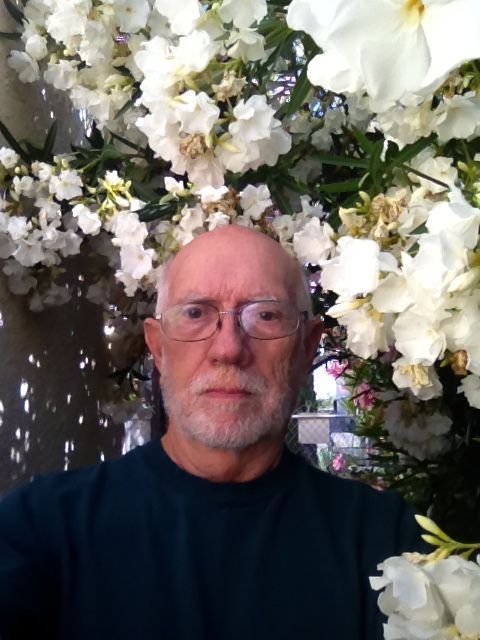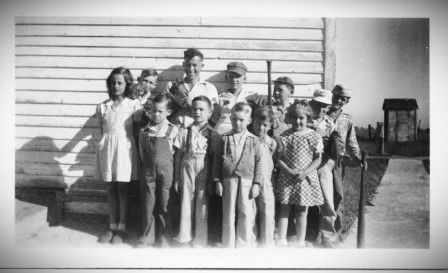Thursday's Columns
March 28, 2024
A Westphalia Guest Column
Brush Country
The Story of a Poem
by
Richard Green
retired professor of art and art history
(and a "proud Westphalian")

Richard Green

Richard's schoolmates in front of their one-room schoolhouse in rural Missouri.
Here I am in the South of Texas, solitary observer beneath a canvas dome of gray winter sky.
I say “South of Texas” purposely to add some allure to this featureless country, as in “South of France.” No one ever says, “south France.”
Call it what you will, the South of Texas is still what it is: coastal plains, a hundred flat miles to the Gulf. Brush country. Mesquite, huisache, prickly pear.
No matter. The winter in the south of Texas is actually pretty mild, for the most part, on the cusp of being sub-tropical. But, still, you can’t help but know that it’s that bleak season.
I submit to my surroundings, all featureless except for a slight rise in the distance with a row of black bare-limbed trees standing out against the clouded sky on its ridge.
Sometimes the great gray canvas dome dissolves into my past.
I’ve always had an acute awareness of unadorned nature. Perhaps being a kid on a Missouri farm makes you close to animals and plants. You develop in those impressionable years an intimacy with things, particularly if you are an only child within miles of similar farms, all operated by people whose kids have grown and moved away and you see their grandkids maybe once a year.
Of course, there were kids at school. Perhaps a dozen first to eighth graders in the same schoolhouse our parents and grandparents attended. You might think that that severely limited opportunities for learning, but I look back fondly on how much attention we all got and how much play time we had, not just unsupervised recess time, but creative activities related to classes. In a section on Asia, I made a terrific papier-mâché tiger. Once a week we studied great paintings. I still have my Crayola copy of Cezanne’s “Blue Vase.”
Things changed. My parents divorced. I continued to live on the family farm until my grandparents were too old to do chores and we moved to New Mexico, where my mother got a job at White Sands Proving Ground -- where the first atomic bomb was exploded.
Cultural change! Farm to city, all strangers, sunshine, Spanish spoken everywhere, adobe architecture, plains to desert, cactus, and mountains! Landscapes chiseled in stone.
I had an inspiring art teacher in high school. I began to think of art as a career. At New Mexico State University, two art professors in particular recognized the value of perseverance, in both art and life.
I learned and then taught drawing and painting in oil and watercolor.
Oil is forgiving. If you don’t like what you’ve done, you can scrape it off, add it on, make it thick or thin, opaque or translucent, smooth or rough. It is accommodating to change since it can take a long time to dry.
Watercolor is less forgiving and less accommodating. It is always thin and translucent and takes on the texture of the paper, smooth (hot-pressed) or rough (cold-pressed), which is made out of linen. It dries fast.
There are rules for both, but since Van Gogh nobody follows the oil rules. On the other hand, watercolor has become a religion.
The English invented watercolor, and you know how they are, queuing and all that. Just remember Rule Number One: never use white pigment, only the white paper tinting the color.
Watercolor changes you. After making a few paintings you start to see the world in terms of watercolor: spontaneous, direct, fresh, reduced to essentials.
I live in a small house with room for my studio behind the house where my daughter and her husband live at the edge of where San Antonio comes up against the Texas brushlands.
I think how winter can reduce everything to grayness, to sameness. To featurelessness. The very thought of spring and change seems remote and vague, even irrelevant. Winters past, winters of the future. For a moment I feel like Dr. Who stepping out of a phone booth. Where are we? When are we? Black bare branches expressing the motion of an invisible wind, invisible hand. Black bare branches brushing up against the great gray dome of winter’s gray sky.
But then, lifting the gray screen, the painter sees color, watercolors. I’m inspired. I make a quick pencil sketch of the simple scene for a future painting where the bare branches are paintbrushes coloring the sky all the vibrant colors of life and hope.
But the colors in my mind are not what I see with my eyes, which need words to come alive. Watercolor insinuates itself in another direction – into language, literary allusion.
Painting dribbles into poetry.
Trees like Paintbrushes
Trees like paintbrushes
Loaded with watercolor
Spread gray across the sky
Who knows what season this is?
It might be winter
Late autumn
It might be early spring
Could be yesterday
Do you know what day it is?
Could be tomorrow
Payne’s gray or watered-down black
It all spreads the same
Across the wet linen sky
